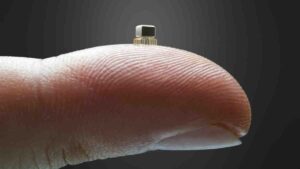‘Pick and shovel’ investing: Why Weebit Nano and these ASX stocks could profit from the AI boom

'Pick and shovel' tech firm Weebit Nano looks to ride the AI wave. Picture Getty
- Weebit Nano share price has tripled in the past 12 months
- The semiconductor company is benefiting from the pivot toward digitisation
- Stockhead reached out to Weebit’s CEO, Coby Hanoch
Thanks to the artificial intelligence (AI) boom, Nvidia Corp has now become one of the most valuable companies in the world after crossing the trillion-dollar (USD) market cap a couple of weeks ago.
Other companies belonging to that coveted trillion dollar club include Apple (US$2.9T), Microsoft (US$2.5T), Alphabet ($1.6T), and Amazon ($1.3T).
Nvidia’s shares surged as tech companies scramble to buy the company’s advanced GPU chips to power the super computers needed in crunching massive amount of data. ChatGPT for example required around 20,000 Nvidia chips to process its AI training data.
Like previous tech booms, Nvidia’s rise is a reminder that it’s the ‘picks and shovels’ investing strategy which could profit the most from the next wave of development.
On the ASX, one company that’s been riding that wave is semiconductor tech company, Weebit Nano (ASX:WBT). WBT’s share price is up over 70% in the past six months, and more than 220% in the past 12.
Weebit’s CEO, Coby Hanoch, says semiconductors have become an integral part of our lives and there’s hardly anything that you can touch or look at today that doesn’t have semiconductors in it.
“Everything is now moving in that direction, and at the government level, semiconductors have become a very strategic thing,” he told Stockhead.
Indeed governments in the US, Europe and giant companies like Samsung and TSMC are pouring in hundreds of billons of dollars into the industry right now.
“Data shows that it’s supposed to be over a trillion-dollar market in five or seven years’ time, and the industry keeps pushing the limits, especially now with AI and autonomous vehicles booming.”
Memory chips to power AI
Hanoch explained that within the semiconductor domain, you have the memory segment which is currently the largest segment.
And within that space, you have two main types of memory: the Volatile Memory, and Non Volatile Memory (NVM).
Volatile Memory – such as DRAM (Dynamic RAM) and SRAM (Static RAM) – loses data when the system is powered down.
NVM, on the other hand, does not need a constant supply of electricity to store data, and this makes it ideal for applications that require low power consumption, high reliability, and fast access to data.
Weebit focuses on the NVM segment through its ReRAM (resistive random access memory), a technology that’s billed as the next generation NVM.
“Think about all the TikTok and Instagram clips and movies that are uploaded. Think of all the surveillance cameras that are out there that keep recording things,” says Hanoch.
“And think of the amount of data that AI requires. All of that needs to be on some memory somewhere,” he added.
The market potential for ReRAM
Until today, Flash memory has been a widely used NVM technology, but as the semiconductor industry continues its march toward ever faster and smaller chips, Flash hasn’t been able to catch up.
“Flash has managed to survive for so long. But it’s been hitting many, many walls. It’s just not fast enough,” explained Hanoch.
Not only that, Flash and all these types of memory cells have gotten nearly as small as they can get.
“In semiconductors, everything is about shrinking. Moore’s Law states that every two years, we manage to put double the amount of semiconductor elements on the same piece of silicon.
“So we’re constantly shrinking and putting more and more onto that little piece of silicon. And Flash can’t do that any more.”
ReRAM meanwhile combines the advantages of both RAM and Flash.
ReRAM is non-volatile (no power needed to keep data), extremely fast, low-power and cost-effective, and can store data as resistance as opposed to an electrical charge that needs electricity supply.
The use cases for ReRAM are numerous and, among many other things, include Edge AI-like smart devices, Internet of Things and autonomous vehicles.
“Practically every device in the world needs to have some software in it, and that software needs to sit on some memory which is non volatile,” says Hanoch.
For autonomous vehicles specifically, components that operate on low power are needed because many of these cars are now battery operated.
“The memory chips on these cars also need to be very fast because we’re talking about human lives and when something happens, you want the car to react as fast as possible. Every millisecond counts.”
“We’re working now with other companies in other domains such as medical, IoTs, and industrial,” added Hanoch.
The next phase stage of growth for Weebit is expected to be commercial agreements with integrated device manufacturers (IDMs) and licensing agreements with Tier-1 foundries – where discussions are currently ongoing.
“Investors are waiting for us to announce commercial agreements, and we’re totally focused on that. It’s something that I, as CEO, wake up and go to sleep with. We’re pushing forward on that front.”
Weebit Nano share price today:
Semiconductor related stocks on the ASX
Archer is another Aussie-listed technology company that builds advanced semiconductor devices, including processor chips that are relevant to quantum computing.
The company is developing the 12CQ quantum computing chip – a world-first qubit processor technology that would allow for mobile quantum-computing-powered devices.
The Victoria-based company makes smart chips based on MEMS technology for tracking very low temperature biological samples, down to -196 degrees Celsius.
The company says the tech has applications in the healthcare industry, particularly businesses that require cryogenic storage facilities (biobanks and biorepositories) as well as markets including cold chain logistics/supply chain, security/defence, industrial/manufacturing and aerospace/aviation.
Another Australian is BluGlass, which is developing semiconductor manufacturing tech using a process called remote plasma chemical vapor deposition (RPCVD), or the manufacture of high-value semiconductor devices such as laser diodes, next generation LEDs and microLEDs.
The entire laser market is worth about $25 billion, with the five sectors it operates in worth about $2.5 billion, and the total addressable market of industrial applications, medical devices and research and defence sit around US$380 million.
Revasum sells equipment used in making semiconductors, a selection of very expensive automatic machines involved in grinding and polishing.
Revasum’s equipment helps drive advanced manufacturing technology for growth markets including automotive, IoT, and 5G.
This company specialises in non-volatile memory technology and is pioneering an interface switching ReRAM for next generation gigabyte storage in mobile and cloud.
4DS recently announced the granting of an additional USA patent. All 4DS patents have been developed in-house and are free from any royalty and or licensing obligations.
4DS now owns an extensive portfolio of USA patents that ring fence and protect its Interface Switching ReRAM technology.
Brainchip has basically developed an ultra-low power, AI neural processor that is capable of continuous learning – which allows customers to create ultra-low power chips and systems with the ability to incrementally learn on-chip without the need to retrain in the cloud.
So, it can think with ultra-low power consumption because it eliminates the power usage caused by interaction and communication between separate elements, and avoids dependency on network connections to powerful remote computer infrastructures.
Pivotal makes gas-flow monitoring and control technology used while making semiconductors, which require precise flows of gas to shape the underlying wafer on which the circuits are built.
The company has a blue-chip client base and has been developing next-generation Gas Flow Control solutions for more than a decade.
The views, information, or opinions expressed in the interview in this article are solely those of the interviewee and do not represent the views of Stockhead.
Stockhead has not provided, endorsed or otherwise assumed responsibility for any financial product advice contained in this article.
Related Topics
UNLOCK INSIGHTS
Discover the untold stories of emerging ASX stocks.
Daily news and expert analysis, it's free to subscribe.
By proceeding, you confirm you understand that we handle personal information in accordance with our Privacy Policy.








